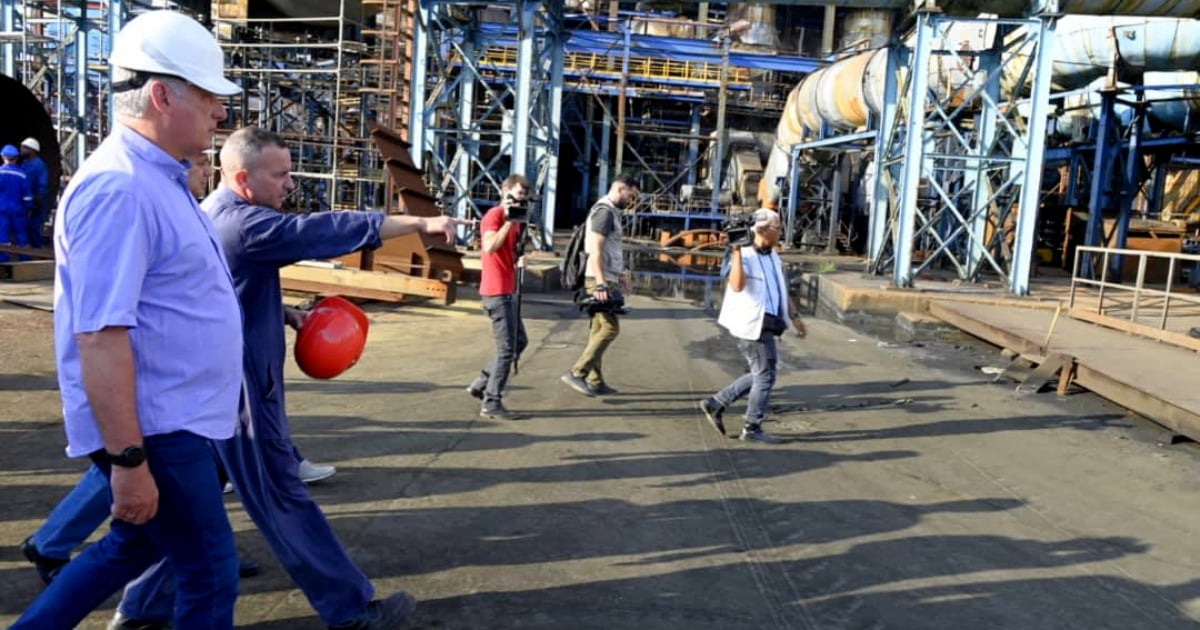The Cuban National Electric System (SEN) continues to collapse, and the Unión Eléctrica de Cuba (UNE) has announced that blackouts will peak at 620 MW this Saturday. This is a slight improvement compared to the more than 1,100 MW outages reported in recent days.
The simultaneous breakdown of seven thermoelectric units due to "failures" has led to further tightening of the electricity supply across the country. This has resulted in frequent and prolonged blackouts throughout the island, including in the capital, which typically experiences fewer disruptions.
The deficit has forced provincial electricity companies to inform their customers that they must abandon the "rotation" of blackout schedules. Instead, all circuits will be plunged into darkness simultaneously in provinces like Matanzas and Pinar del Río.
For this Saturday, "an availability of 2,600 MW and a maximum demand of 3,150 MW is estimated for peak hours, resulting in a deficit of 550 MW. If current conditions persist, a 620 MW impact is expected during this period," according to an informational note published on social media by the state-owned company led by Alfredo López Valdés. "Yesterday, service was disrupted for 24 hours due to capacity deficits," a situation that has been recurring throughout the summer.
The previous day, the "maximum impact was 1,160 MW at 20:20 hours, coinciding with peak time," according to the UNE. Of the seven malfunctioning units reported days earlier, three have been reconnected to the SEN this Saturday.
The units still out of service include unit 5 of the CTE Máximo Gómez (Mariel), unit 1 of the CTE Ernesto Guevara (Santa Cruz), unit 5 of the CTE Antonio Maceo (Rente), and unit 2 of the CTE Lidio Ramón Pérez (Felton). The UNE expects the latter to be operational by peak hours on Saturday but did not specify when it would sync with the SEN.
Leader Miguel Díaz-Canel, along with his ministers, leaders, and the UNE, promised that blackouts would decrease in the summer due to repair and maintenance work on Cuban thermoelectric plants conducted in the months leading up to the summer season.
Failed Promises and Growing Discontent
The strategy to maintain and upgrade thermoelectric plants to reduce blackouts during the hottest months and school vacations has proven ineffective, sparking a daily avalanche of comments on UNE's social media platforms.
After making several optimistic statements predicting a stable summer for electricity generation, the Cuban leader has since disappeared from the public eye and is no longer seen "leading" or overseeing the effectiveness of his strategy.
In late May, Cuban state media prominently featured Díaz-Canel's visit to the Ernesto Guevara thermoelectric plant in Santa Cruz del Norte. This visit was part of the routine coverage of his tours, but it also highlighted his commitment to stabilizing the National Electric System, as he had promised in his YouTube program, Desde la Presidencia.
The website of the Cuban Presidency showed Díaz-Canel overseeing maintenance actions in Santa Cruz del Norte, indicating that "due to the priority of restoring generation capacities, the leader began his visit to the Mayabeque municipality at the thermoelectric plant, which is currently undergoing maintenance on two of its three units."
"We will have prolonged maintenance until June to minimize the inconvenience of blackouts in the summer, especially in July and August," Díaz-Canel promised on his program. However, he admitted that it was impossible to offer "guarantees that the summer months will pass without disruptions in the electrical service."
"In July and August, all stations will be operational unless a failure occurs," stressed the leader appointed by General Raúl Castro, emphasizing that "under current conditions, it is very difficult to promise zero blackouts."
"There may be a blackout at a certain time, but we will work to ensure they are not prolonged or of long duration," added the First Secretary of the Communist Party of Cuba.
Three months after his series of promises, the Cuban leader has not returned to a thermoelectric plant. The SEN has further collapsed, but he spent all of July in Olympic mode and now has his arm in a sling due to severe shoulder pain.
Yet, his conscience remains untroubled, and the leader of so-called "continuity" continues to bet on "creative resistance" and the heroism of the people to overcome the current energy crisis.
Understanding the Cuban Energy Crisis
Given the ongoing energy crisis in Cuba, many questions arise about the root causes and potential solutions. Here are some frequently asked questions and their answers to provide a clearer understanding.
What led to the current energy crisis in Cuba?
The crisis is primarily due to the simultaneous breakdowns of multiple thermoelectric units and the inefficiency of the maintenance strategy implemented by the government.
How has the Cuban government responded to the energy crisis?
The government, led by Miguel Díaz-Canel, has promised repairs and maintenance to reduce blackouts. However, these efforts have proven ineffective, and the situation has worsened.
What impact has the energy crisis had on daily life in Cuba?
The crisis has led to frequent and prolonged blackouts, affecting all aspects of daily life, including businesses, healthcare, and education.
